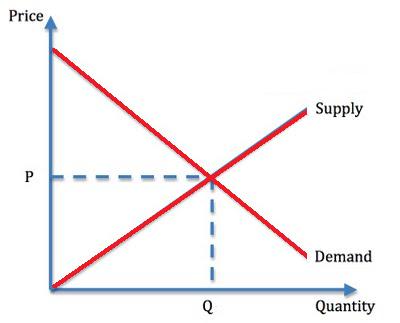In pure competition, the firm has to accept the given market price. At this given price, it can sell all the products, which it desires but at any higher price, it cannot sell anything. If the market price is below its cost, it has to either take the loss or withdraw from the market. As a result, any single firm in a purely competitive situation has to adjust its production and sales policies to the given market price. However, the market prices arc determined through the mutual consent of all the individual competitive buyers and sellers together. But any individual firm has no control over the price. Since a purely competitive seller has no control over the price at which Continue reading
Economics Principles
Perfect Competition – Perfectly Competitive Market
Perfect competition is a market situation where large number of buyers and sellers operate freely and commodity sells at a uniform price. In such a situation no seller or buyer has any influence on the market price. In a perfectly competitive market, a firm is the price taker and industry is the price maker. Main Features of Perfect Competition The main features of perfect competition are as follows: There are a large number of buyers and sellers. Each seller must be small and the quantity supplied by any seller must be so insignificant that no increase or decrease in his output can appreciably affect the total supply and the market price. So also, each buyer must be small and the Continue reading
Price Analysis and Theory of the Firm
To understand the concept of market and its various conditions, it is necessary to study the theory of the firm. This is discussed as follows: The basic, assumptions of the theory of the firm are as follows: The objective of a firm is to maximize net revenue in the face of given prices and technologically determined production function. A price increase far a product raises its supply, whereas prices increase for a factor reduces its demand. The theory of the firm deals with the role of business firms in the resource allocation process. It uses aggregation as a tactic and attempts to specify total market supply and demand curves. The firm operates with perfect knowledge of all relevant variable involved Continue reading
Survival of the Fittest in Business
“The law is the survival of the fittest…. The law is not the survival of the ‘better’ or the ‘stronger,’ if we give to those words any thing like their ordinary meanings. It is the survival of those which are constitutionally fittest to thrive under the conditions in which they are placed; and very often that which, humanly speaking, is inferiority, causes the survival.” €• Herbert Spencer At any given time, there may be firms of varying sizes and efficiency in an industry, possibly some making profits and others incurring losses. As long as industry is open for anyone to enter freely, an excess of price over the attainable average total costs will encourage the entry of new firms. Continue reading
Cost Control Concepts
The long-run prosperity of a firm depends upon its ability to earn sustained profits. Profit depends upon the difference between the selling price and the cost of production. Very often, the selling price is not within the control of a firm but many costs are under its control. The firm should therefore aim at doing whatever is done at the minimum cost. In fact, cost control is an essential element for the successful operation of a business. Cost control by management means a search for better and more economical ways of completing each operation. In effect, cost control would mean a reduction in the percentage of costs and, in turn, an increase in the percentage of profits. Naturally, cost control Continue reading
Determinants of Demand
The knowledge of the determinants of market demand for a product or service and the nature of relationship between the demand and its determinants proves very helpful in analyzing and estimating demand for the product. It may be noted at the very outset that a host of factors determines the demand for a product or service. In general, following factors determine market demand for a product or service: Price of the product Price of the related goods-substitutes, complements and supplements Level of consumers income Consumers taste and preference Advertisement of the product Consumers expectations about future price and supply position Demonstration effect or ‘bend-wagon effect’ Consumer-credit facility Population of the country Distribution pattern of national income. These factors also include Continue reading


